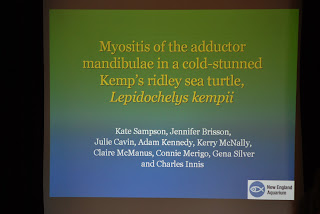Hi All,
I decided to postpone the
NERS workshop blog post in favor of an oil spill update. The spill is generating a lot of questions and concern so this issue clearly takes precedence over a more lighthearted blog, I'll get to the workshops later.
Since the beginning of the oil spill disaster, over 100 sea turtles have washed up dead along a vast stretch of coastline in the Gulf of Mexico. Those animals are being carefully dissected by
NOAA Fisheries pathologists and so far have shown no visual signs of oil contamination. Histology samples are being collected in each case for histological examination and will reveal more information once those tissues have been examined in the lab. As I mentioned in a previous blog, it is important to note that this is typically a busy stranding time in the Gulf region. However, I do not know how 100+ sea turtles compares to a "typical" season in that region so I will refrain from making assumptions.
The dolphin count is significantly lower then the turtle count, with a total of 6 dead bottlenose dolphins. As in the case of the sea turtles, these dolphins did not show external signs of oil contamination. Histological findings will be important on these animals as well.
According to the International Bird Rescue Research Center (IBRRC) blog, 12 oiled birds have thus far been documented. Species include: brown pelican (3), Northern Gannet (5), Green Heron (1), Laughing Gull (1) Magnificent Frigatebird (1) and Royal Tern (1). This site has a chart of the impacted birds and the species, which is a great quick reference guide to the oiled bird count. I'm not entirely sure but I believe the chart might be only for animals found alive. I noticed the mention in the IBRRC blog of a dead Surf Scoter collected from a beach however I do not see this animal listed on the chart.
I borrowed these photos directly from the ICRRC blog. The photos show a brown pelican before and after the animal had been cleaned of the oil product. What a dramatic difference in this animal post cleaning!

(via
intbirdrescue.blogspot.com)
Also of great importance and concern are new projections out this morning posted on
The Weather Channel (TWC) website. Authors Tim Ballisty and Jon Erdman wrote
a great article on the potential for this oil spill to enter the Loop Current ... if it already hasn't. Ballisty and Erdman quote Dr. Richard Knabb, a tropical expert for TWC, regarding his expert opinion based on many factors including information from researchers on the water in the Gulf, computer model simulations and NASA generated satellite images. Dr. Knabb states that "the oil slick at the surface is very near or partially in the loop current." He goes on to state that "with its proximity to the northern edge of the Loop Current it may be only a matter of weeks or even days before the ocean surface oil is transported toward the Florida Keys and southeast Florida."
This photo from TWC website show a satellite image of the spill. Of concern is the oil slick heading in a southeast direction. 
(via
weather.com)
Another photo from TWC website shows an image of the path of the Loop Current. This photo paints a clear picture of Dr. Knabb's concern.
(via
weather.com)
So far the oil has not reached the shoreline along the Gulf, good news for animals and humans. In the coming days I'll blog on the species at risk in the Gulf and provide more updates.
- Connie
[Read previous posts about the oil spill
here and
here.]






















































